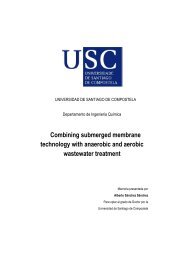Create successful ePaper yourself
Turn your PDF publications into a flip-book with our unique Google optimized e-Paper software.
9.3 PLATON - ANALYSE Menu <strong>WinGX</strong> <strong>v1.64</strong><br />
5.2 Disorder<br />
The program attempts to manage the problems that are encountered with several types of<br />
disorder. Only two-fold disorder is allowed. Populations higher than 0.5 are understood as<br />
major disorder components and those less than 0.5 as minor disorder components. The usual<br />
transformations on input coordinates are restricted. In general it will be necessary to supply<br />
disordered molecules as connected sets. The calculation of distances and angles etc. will<br />
extend only to entities involving the major disorder component or the minor disorder<br />
component but not both.<br />
5.3 Molecules and Residues<br />
The concepts of molecules and residues are related but not always synonymous within the<br />
PLATON realm. A residue is defined as a part of the structure that is connected by intramolecular<br />
bonds only and is associated with a number. A structure may thus contain one or<br />
more residues. Residues may be chemically equivalent or chemically distinct. A molecule is<br />
defined as an asymmetric part of the structure connected by intra-molecular bonds only.<br />
Several molecules may join by crystallographic symmetry into one residue. A particular<br />
molecule is designated by a code: [nijk.rr] where n denotes the symmetry operation with<br />
respect to the basic molecule, ijk the translation with respect to 555 and rr the residue number.<br />
The structure of sucrose thus consists of two molecules (e.g. [1555.01] and [2545.01]) but<br />
only one residue.<br />
6. Parameter files<br />
The atomic parameters (including unit cell parameters, coordinates and temperature<br />
parameters) for a given structure may be input in various ways: the STANDARD<br />
PARAMETER FILE Format (SPF), SHELX type .INS/.RES files, simple XYZ Angstrom<br />
coordinate format, CIF, PDB, CSD-FDAT formats<br />
The SPF-format is card image oriented. The first four characters on a card specify the nature<br />
of the data that follow on that card. Data that are not needed for the current program are<br />
simply skipped. All data are in free format.<br />
6.1 The SPF format<br />
TITL text<br />
This text may be used for various titling purposes. It may be overridden at any time by<br />
another TITL instruction.<br />
CELL (wavelength) a b c alpha beta gamma<br />
Optional wavelength and cell parameters in Å’s and degrees respectively. No CELL card is<br />
needed for Å data input. The wavelength is used for the calculation of the linear absorption<br />
coefficient.<br />
CESD sig(a) sig(b) sig(c) sig(alpha) sig(beta) sig(gamma)<br />
This optional card specifies standard deviations in the cell parameters. No CESD card is<br />
needed for Angstrom data. The cell e.s.d. is combined with the coordinate e.s.d. for the<br />
calculation of the e.s.d. in derived parameters.<br />
Chapter. 9.3 PLATON 24

















